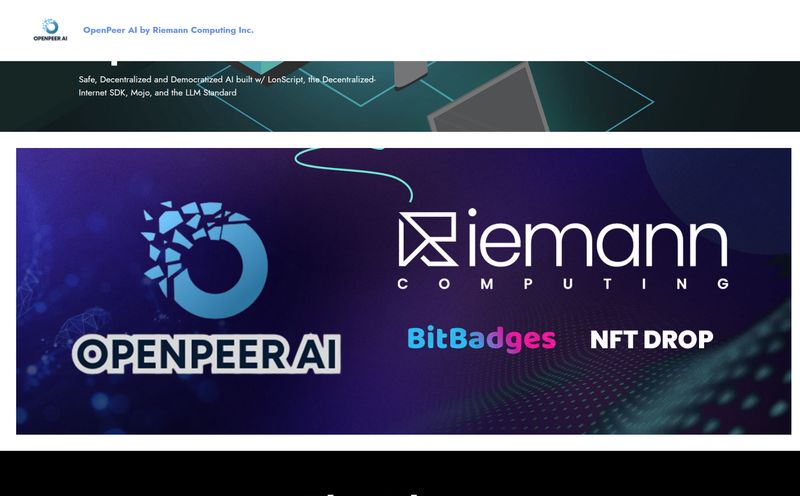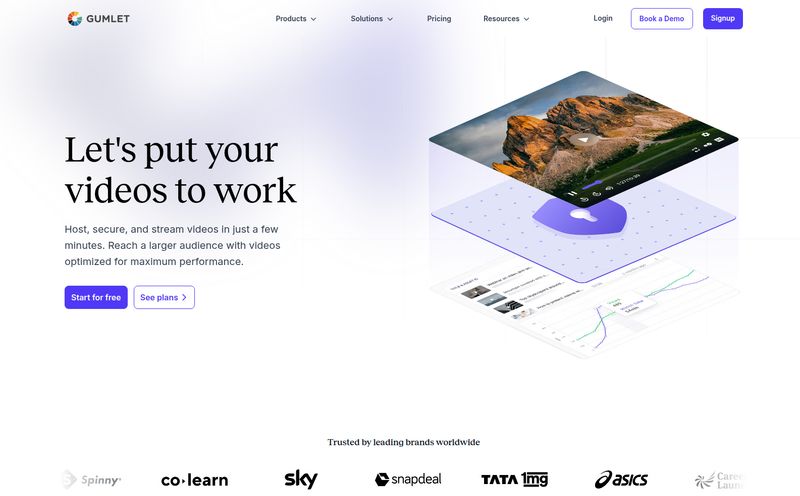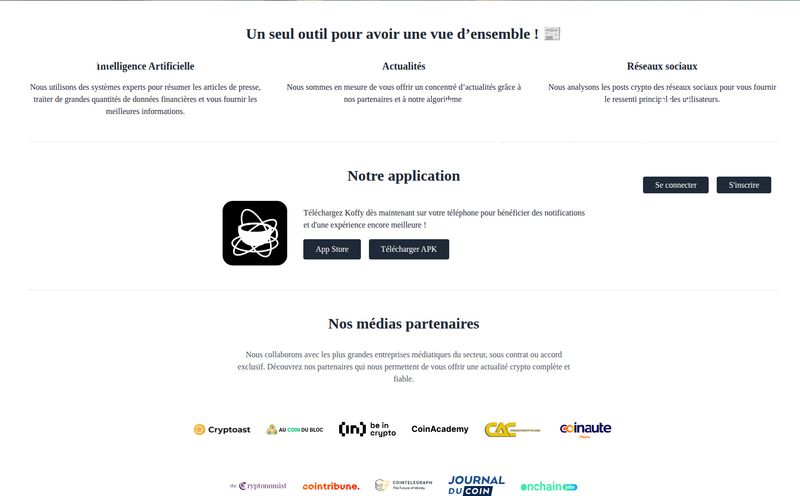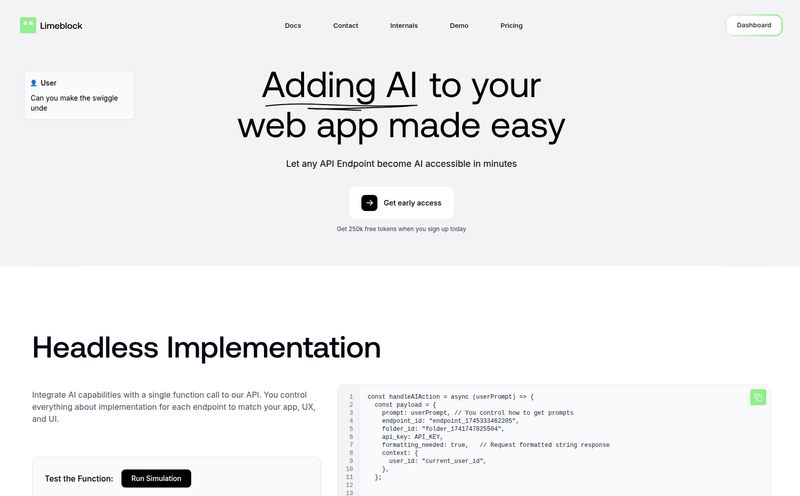Let me tell you, I've been around the block a few times in the digital world. I’ve seen trends come and go, from the early days of CPC bidding wars to the current madness of generative AI. But there's one problem that has remained stubbornly, infuriatingly consistent in any project involving 3D: the art pipeline bottleneck.
You know what I’m talking about. The endless back-and-forth. The concept art that looks amazing but is a nightmare to model. The feedback loops that stretch for weeks. It’s a time-sucking, budget-draining monster that haunts game developers and product designers in their sleep. It’s the reason so many brilliant ideas never see the light of day. So when a tool like Kaedim pops up on my radar, promising to turn 2D images into 3D models at “10x speed,” my cynical, battle-hardened SEO brain kicks in. Is this for real? Or just more AI hype?
Spoiler alert: It’s a bit more interesting than a simple yes or no.
So What Exactly is Kaedim?
At its core, Kaedim is an AI-powered platform designed to automate the conversion of 2D images—think concept art, photos, sketches—into production-ready 3D models. But here’s the twist, and it's a big one. It’s not just an algorithm running wild on a server somewhere. Kaedim uses what they call an end-to-end pipeline, which is a fancy way of saying they combine their powerful AI with a team of actual human artists for quality control.
This, for me, is the secret sauce. It’s not trying to completely replace artists. Instead, it’s building a tool to make them superhumanly fast. Think of Kaedim less like a magical 3D printing press and more like a brilliant, impossibly fast apprentice modeler who gets the basic forms, geometry, and proportions about 80% right in a fraction of the time. Then, a senior artist comes in for that final 20% polish, adding the details and ensuring the asset meets professional standards. That’s a game-changer.
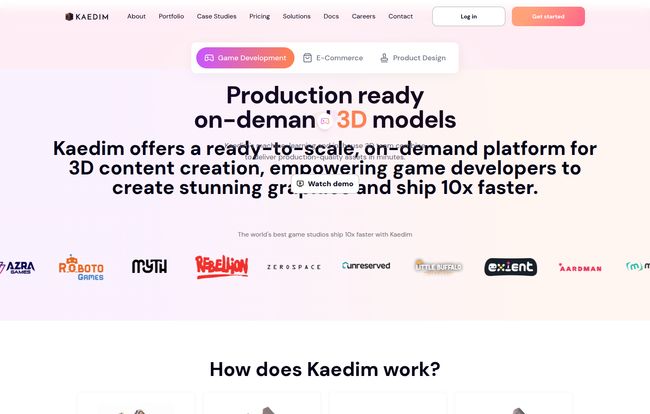
Visit Kaedim
The Kaedim Workflow in a Nutshell
The process itself sounds beautifully simple, which is exactly what you want when you're trying to fix a complicated problem.
- The Spark of an Idea: You start by uploading your 2D input. This could be a detailed piece of concept art for a new game character, a photo of a product for an e-commerce store, or even just a clear description of what you need.
- The AI's First Pass: This is where the machine learning kicks in. Kaedim's AI analyzes the image, understands the shapes, depth, and texture, and generates a base 3D model. This is the step that does the heavy lifting, saving hundreds of hours of manual block-outs and modeling.
- The Human Touch: Your newly generated asset is then passed to Kaedim's internal team of artists. They review the model, clean up any weird geometry, refine the details, and make sure it's up to snuff. This quality assurance step is what separates it from a fun AI toy to a legitimate production tool.
- Ready for the Engine: Once it passes QA, the model is delivered to you, ready to be dropped into your game engine, product viewer, or design software.
This hybrid approach elegantly sidesteps one of the biggest problems with purely generative AI: the uncanny valley and the lack of finesse. The AI provides the speed; the humans ensure the quality.
The Real-World Benefits of AI-Assisted Art
Okay, the process sounds neat. But what does this actually mean for a studio or a business? How does it affect the bottom line and the timeline? From what I can see, the advantages are pretty substantial.
Busting Through the Art Bottleneck
Kaedim claims to be 10x faster. Let's just pause on that. In game development, speed isn't just a nice-to-have; it's survival. A faster art pipeline means more time for iteration, more time for polishing gameplay, and a shorter path to launch. It means your creative director can see a 3D version of their idea in hours, not weeks, allowing for faster decisions and pivots. Getting an asset that's 80% of the way there eliminates the most time-consuming part of the modeling process, freeing up your in-house artists to focus on high-value tasks like final texturing, rigging, and unique hero assets.
Making Scalable Art Production Actually Possible
I’ve worked with companies that have had to manage dozens of freelance 3D artists at once. It's a logistical nightmare of contracts, communication styles, quality control, and feedback. Kaedim proposes a much simpler solution: a single, on-demand platform. Need 100 props for your new environment? Or 500 product models for your website? Instead of juggling vendors, you have one pipeline. This is huge for scalability. You can ramp up or down your asset production on demand, without the overhead of hiring or the chaos of managing a legion of freelancers. It’s a much cleaner way to operate.
Custom Styles and Fine-Tuning
One of my initial worries was, “Okay, but does it just spit out generic-looking models?” According to their site, no. They offer services to fine-tune the AI to your specific art style. For a game studio with a strong, unique visual identity—think of the distinctive look of games like Hades or Fortnite—this is critical. Your assets need to feel like they belong in your world. The ability to train the system on your IP ensures consistency and keeps your project's artistic vision intact.
Okay, Let's Be Realistic. What are the Downsides?
No tool is perfect, and it’s my job to be skeptical. While Kaedim looks incredibly promising, there are a few realities to consider.
The "Garbage In, Garbage Out" Principle
The AI is smart, but it's not a mind reader. The quality of your 3D model is going to be heavily dependent on the quality of your 2D input. A vague, muddy sketch with unclear perspective is going to yield a vague, muddy model. You still need skilled concept artists who can produce clear, well-defined imagery for the AI to work with. This isn't a tool to save a bad idea; it's a tool to accelerate a good one.
The Human Element is Still There
The manual refinement stage is a huge plus for quality, but it also means it's not an instant process. You won't be getting a final, game-ready asset the second you click a button. There's still a human-in-the-loop, which means there's a turnaround time. It's drastically shorter than the traditional method, but it's not zero. Anyone expecting a completely automated, instantaneous magic box might need to adjust their expectations.
The Big Question: What's the Kaedim Pricing?
Ah, the classic enterprise software conundrum. If you browse over to Kaedim's website, you won’t find a neat little pricing table with three tiers. Instead, you'll find a "Get a quote" form. Honestly, this always makes my wallet clench a little. It's the universal sign for "this is a business solution, not a hobbyist tool." The pricing is likely customized based on the number of assets you need, the complexity, the level of integration, and the style-matching requirements. While this makes perfect sense for a B2B service, it does mean that small indie developers or solo creators might find it out of reach. It's tailored for teams with a real budget allocated for art production.
Who is Kaedim Actually For?
After digging through their site and case studies with studios like Mythical Games and Ready Player Me, a clear picture of the ideal customer emerges. Kaedim seems perfectly positioned for a few key groups:
- Indie and AA Game Studios: Teams that have big ambitions but lack the massive in-house art departments of a AAA giant. Kaedim can act as a force multiplier, allowing them to create more content and compete on a larger scale.
- AAA Game Studios: Even the biggest studios are always looking for efficiencies. Kaedim can be used to rapidly prototype ideas or handle the sheer volume of background assets and props, freeing up their world-class artists to focus on the hero characters and set pieces.
- E-commerce and Retail Businesses: Imagine being able to create a 3D model of every product in your catalog for AR viewers and interactive web displays, without a massive upfront investment in 3D scanning or modeling. This is a huge area of growth.
My Final Thoughts
So, is Kaedim the cure for the 3D asset headache? I think for many, the answer is a resounding yes. It's one of the smartest applications of AI in the creative space I've seen in a while. It’s not trying to make artists obsolete; it’s building a powerful tool to put in their hands. The hybrid AI-and-human approach is the right call, focusing on production value over novelty.
It’s a pragmatic solution to a real, expensive problem. While the custom pricing model might gatekeep smaller creators, for any established studio or business that feels the constant pain of a slow and expensive 3D pipeline, Kaedim is absolutely something you should be looking into. It could very well be the competitive edge that lets you build bigger worlds and ship better products, faster.
Frequently Asked Questions about Kaedim
Is Kaedim a full replacement for a 3D artist?
Not at all. It's an accelerator. You still need artists for high-quality concept art, and your in-house team is still vital for final polish, texturing, rigging, and implementing the assets. Kaedim replaces the most time-consuming part of the initial modeling process.
What kind of 2D images work best with Kaedim?
Clear, well-defined images are best. High-quality concept art with clear silhouettes and defined forms will yield the best results. A single frontal view can work, but providing multiple angles (front, side, back) will give the AI even more information to create an accurate model.
Can Kaedim create animated or rigged 3D models?
The primary service is creating the static 3D model (the geometry). While they deliver game-ready assets, complex rigging and animation would typically be a separate, subsequent step in your own production pipeline. They provide the clean canvas for your animators to work with.
How does Kaedim handle different art styles?
Kaedim can be fine-tuned to match a project's specific art style. This is part of their enterprise service, where they work with a studio to train their models on existing IP to ensure all new assets are visually consistent with the established world.
What file formats does Kaedim export?
They deliver assets in standard, game-ready formats like .fbx, .obj, .gltf, and .usd, which are compatible with major game engines like Unreal Engine and Unity, as well as 3D software like Blender and Maya.
Is there a free trial for Kaedim?
Their website doesn't advertise a public free trial. Access is typically granted after a consultation and quote process, as the service is tailored to the needs of professional studios and businesses.
